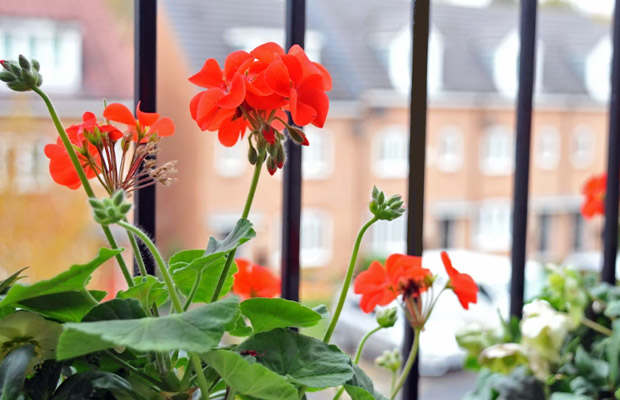For adding color to window boxes, borders, and beds, home gardeners love vibrant geranium flowers. How to propagate geraniums?
The following step-by-step instructions make it simple for beginners to grow geraniums from cuttings.
We focus on the process of starting new plants from stem cuttings of existing ones. keep reading!
Table of Contents
How To Propagate Geraniums?
Preparing A Stem Cutting
Any time during the growing season, when a plant has a flush of new growth and just before it starts to set buds, is the ideal time to take a cutting.
Taking cuttings in the fall before the plants go dormant will ensure that you have new, fresh plants to plant out in the spring if you are growing garden geraniums as annuals.
Here’s how to do it:
Pick a stem with strong leaves. Aim to steer clear of the weakest, most recent growth, the oldest, woodiest stems, and any with discolored or damaged foliage.
To cut through a stem, use sharp, well-maintained pruners or a fine blade.
Make the cut four to six inches down from the stem tip, just below a leaf node.
Remove the lower foliage with a pair of scissors, leaving two or three leaves at the top, leaving three to four inches of stem bare. Remove any flower or leaf buds because they could divert energy from the formation of roots.

Rooting Stems In Water
Place the stem in a clean, clear glass or jar that is four to six inches deep
Water should be added to the jar to cover the main stem but not the leaves.
Set up shop in an area that stays between 65 and 75 degrees Fahrenheit on a sunny windowsill.
To keep the water fresh, change it every day. At the base of the stem, roots should start to form after about four weeks.
Rooting In Potting Medium
Water can be replaced with a sterile potting medium as an alternative.
Select a clean container that is four to six inches deep and has adequate drainage holes.
Approximately one-half inch below the rim, fill the container with potting medium. You can dust the cut end of the stem with powdered rooting hormone if you like.
Making a hole in the potting medium, insert the stem, pushing it down into the soil so that it covers all of the leaf nodes that were removed because roots will grow from these nodes.
To securely anchor the stem, pack the potting medium around it.
Place in an area with bright sunlight and a temperature range of 65 to 75 degrees Fahrenheit after giving it a thorough watering. You have the option of using a grow light and heat mat.
Never let the potting medium get soggy or completely dry out; just keep it lightly moist.
Using a clear plastic bag over the pot, some people like to make a miniature greenhouse for cutting. This is a clever way to keep the necessary humidity and temperature in the surrounding area.
If you use this method, be careful not to seal the bag or place the plant in the sun because that could cause it to overheat.
Transplanting
Your cuttings will be healthy once you can see roots through the transparent container or new shoots on the stems emerging from the potting soil.
Your potted cuttings can begin the hardening-off process, which acclimates them to the outdoors when the roots are one to two inches long or you notice new foliar growth.
Make sure to wait until there is no longer any chance of frost if you took your cuttings in the fall.
For a week, leave the plants outside for a few hours each day. Put them in a protected area at first, then gradually move them outside. Any days with bad weather forecasts should be avoided.
It’s time to finish the propagation process by putting your rooted and sprouted cuttings outside in the garden at the end of the week.
How To Care For Geraniums?
Watering
Really, geraniums are very simple to maintain. Unless it is an especially dry period, they don’t need watering after they’ve settled in. The geraniums you grow in pots will require routine watering.
Fertilizing
To improve the soil and encourage flowering the following year, mulch the garden in the fall after you’ve raked up the leaves.
Staking
Apart from the occasional hoops to prevent them from encroaching on a path in their general exuberance and eagerness to please, staking geraniums is not necessary.
Cutting Back Geraniums
Geranium varieties that bloom in the late spring and early summer can be pruned, giving you a clump of new leaves for the remainder of the growing season.
Other varieties flower all season long, but they start to wane in the middle of the summer. Here, getting a general haircut pays off. When you can see some fresh, new leaves beginning to emerge, shear all the leaves back to the ground. The plants will appreciate a watering with seaweed fertilizer and, if you have any, a mulch of garden compost, and hopefully, you will have a new flush of flowers in a few weeks. To avoid having to deal with the close-cropped appearance while on vacation and to be able to return to some lush new growth, I try to complete this task right before I leave.
If you are tough enough, you can also use the “Chelsea Chop” in late May to guarantee a succession of blooms throughout the summer. Choose a few plants (perhaps those that are prone to falling over near a path) and shear them back to half their height just before they are about to flower. This indicates that they will flower a few weeks later than their neighbors, and as a result, they will be stronger and stockier.
Read More: How to Plant Tulip Bulbs in Pots?
FAQs
Can you survive the winter with geranium?
- Keeping geraniums over the winter is possible in a number of ways:
- Keep them inside as houseplants.
- Grow cuttings.
- Geraniums in pots should be kept in a shed, garage, or basement that is kept above freezing.
- Take the soil off, and keep the bare roots in a cool, dark place.
Do geraniums live forever?
Absolutely, and as long as they have winter protection, even the delicate pelargoniums that are frequently mistaken for hardy geraniums are perennial.
When should you take geranium cuttings?
Any time the plant is actively growing, you can take cuttings.
In order to start new plants in pots outside, you might want to take them during the summer.
Additionally, you can take cuttings in the fall and grow them inside over the winter.
Can geranium cuttings be rooted in water?
You can, but I find that planting the cuttings directly in moist soil yields the best results.
Overall, roots that are rooted in water may swell and become fragile, making them difficult to transplant into pots. Many people do root them in water, but in the long run, do it directly in potting soil.
The general rule for plant propagation is that a stem will grow roots in water more readily the younger and less woody it is.
What is the time required for geranium cuttings to root?
The length of time will vary depending on the growing environment, but you should see new root growth in 6 to 8 weeks.
Also Read: How To Plant Lettuce?

















